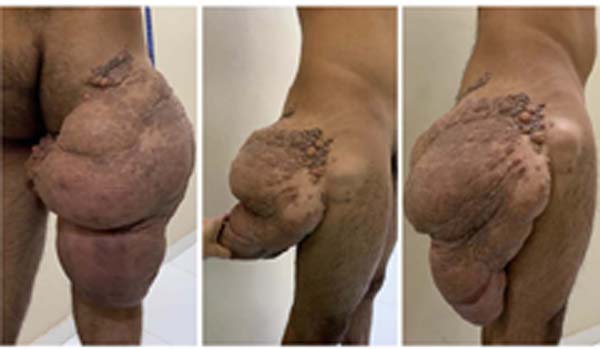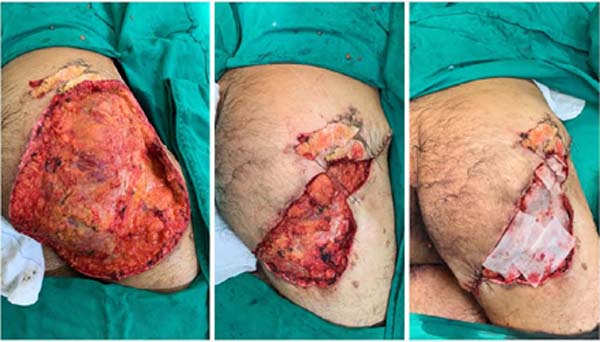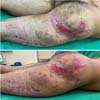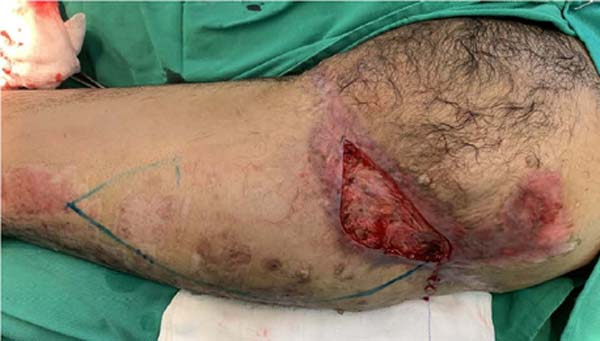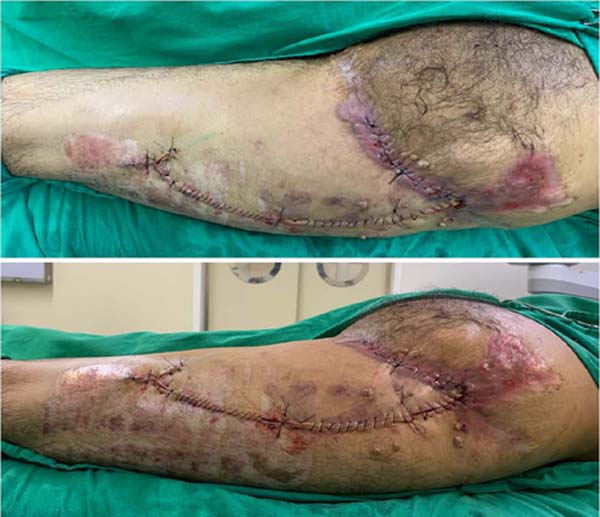INTRODUCTION
Neurofibromatosis is an autosomal dominant disorder, divided into neurofibromatosis
type 1 (NF1), neurofibromatosis type 2 (NF2) and schwannomatosis. NF1 is associated
with an increased risk of forming benign and malignant tumors with neurocutaneous
involvement. The disease predominantly affects the skin, bones, and nervous system,
but the complications are widespread, variable, and unpredictable1.
NF1 affects men, women, and all ethnic groups equally. The incidence at birth is 1
in 2500 to 1 in 3000 and a minimum prevalence of 1 in 4000-5000. In addition to tumors,
café au lait spots are present in 99% of patients with NF12.
The variable evolution, often with limiting tumors, in addition to the significant
incidence of NF1 cases that require treatment, makes it essential to discuss procedures
already carried out in medical practice for early, careful, and individualized recognition
of the diagnosis and treatment of the patient.
OBJECTIVE
This study aims to report a surgical case of neurofibromatosis, calling attention
to the surgical technique and the characteristics of the disease, as well as to the
importance of the procedure in the quality of life of patients limited by the condition.
CASE REPORT
The case report follows the model recommended by SCARE3, being approved by the ethics and research committee of Centro Universitário CESMAC,
with CAEE 61674922.3.0000.0039.
A male, brown, 23-year-old patient sought care at a basic health unit and later at
a public hospital, complaining of a tumor in the buttocks and lateral surface of the
right leg that had been growing for 11 years (Figure 1) in addition to café au lait spots on the distal third of legs 3 years ago (Figure 2).
Figure 1 - Photos of the patient show a large neurofibroma in the buttocks and posterior region
of the thigh.
Figure 1 - Photos of the patient show a large neurofibroma in the buttocks and posterior region
of the thigh.
Figure 2 - Photos of the patient show café au lait spots on the distal third of the right leg.
Figure 2 - Photos of the patient show café au lait spots on the distal third of the right leg.
The patient denied comorbidities and had no personal history of neoplasms or family
history of similar NF1 conditions. Two years before the consultation, with the desire
to remove the mass, he sought assistance from the hospital team, who carried out an
anatomopathological examination, with a diagnosis of fibrolipoma, and a tomography,
which concluded the presence of an infiltrative lesion, affecting the right gluteal
region and proximal portion of the posterior face of the right thigh, measuring 22.2cm
X 23.8cm (LxT), soft tissue density, fat content inside and no signs of muscle invasion
in the area.
After the exams, the patient underwent a surgical procedure with only partially removed
the tumor. The first surgery was performed by another team, with no data regarding
the technique and the justification for the impossibility of removing the entire tumor.
The patient had a great appeal for the total removal of the mass due to limited mobility
(he could not perform his favorite activities, such as running and cycling) and the
difficulty in maintaining interpersonal relationships, which isolated him from social
interactions.
Therefore, with the more accelerated growth of the tumor and café-au-lait spots, he
again sought the hospital for total mass removal. Based on clinical analysis and complementary
exams, which did not indicate muscle invasion, we opted for the procedure for the
total removal of the neurofibroma.
Surgery was performed under spinal and general anesthesia, with the patient in the
left lateral decubitus position. The incision bordered the fibromatous lesion, which
had a greasy appearance. Resection was performed in the plane above the fascia and
hemostasis of the bleeding vessels, which resulted in non-significant intraoperative
blood loss. After removing 6,920 kg of the surgical specimen, the edges of the lesion
were brought together, and a bandage was applied with Rayon gauze and cotton gauze
(Figure 3). There were no complications during the procedure and in the immediate postoperative
period.
Figure 3 - Evolution of the procedure, intraoperatively, for the removal of the neurofibroma.
Figure 3 - Evolution of the procedure, intraoperatively, for the removal of the neurofibroma.
About two months after tumor removal, a skin graft was performed on the hip and thigh
lesion on the right side from skin resection in the ipsilateral coxofemoral region,
using a Brown dressing after grafting in the donor and recipient region (Figure 4). After another two months, a fasciocutaneous flap was performed in VY (Figure 5) in the affected hip and thigh region, with sutures in Donatti and continuous stitches
(Figure 6).
Figure 4 - Postoperative skin graft on the right hip and thigh two months after the procedure.
Figure 4 - Postoperative skin graft on the right hip and thigh two months after the procedure.
Figure 5 - Marking the fasciocutaneous flap area in VY with patent blue.
Figure 5 - Marking the fasciocutaneous flap area in VY with patent blue.
Figure 6 - Immediate postoperative period of the VY fasciocutaneous flap in the hip and thigh
region.
Figure 6 - Immediate postoperative period of the VY fasciocutaneous flap in the hip and thigh
region.
DISCUSSION
The diagnosis of NF1 can be defined with clinical parameters only when two or more
of the following conditions are present: 6 or more café-au-lait spots greater than
5mm in diameter in prepubertal individuals, and more than 15mm after puberty, 2 or
more neurofibromas of any type or 1 plexiform, freckles in the axillary or inguinal
region, an optic pathway tumor, two or more Lisch nodules, a distinct bone lesion
or a first-degree relative with NF1 by the criteria described4.
The use of clinical criteria in the diagnosis evidences a possibility of earlier identification
and management of the condition, preventing lesions, such as those of the patient
in question, from being removed with exacerbated growth and causing limitations.
Regarding the characterization of neurofibroma, in a study by Rozza-de-Menezes et
al.5, the presence of lipomatous dermal neurofibromas, as in the case described, is common
(prevalence of 17.5%). This variant is more frequent in lesions of greater mass. It
is believed that the NF1 mutation can lead to altered lipid metabolism and be related
to the accumulation of lipid droplets in the cytoplasm.
Neurofibromatosis has no cure. Its only treatments are surgical excision or CO2 laser
for cutaneous neurofibromas smaller than one centimeter6. In the patient in question, we opted for excision of the mass, with excellent results
in the immediate postoperative period. Despite the great aesthetic benefit and the
patient’s quality of life, the long-term gain of removing a large number of neurofibromas
by surgery or laser, from the point of view of disease control, has not been proven.
Likewise, laser removal of café au lait stains has not been fully evaluated7.
Regarding future prospects for NF1 control, some treatment alternatives, such as those
related to p21Ras8 protein inhibitors (with the aim of inhibiting angiogenesis), cell differentiation
inducers8, and hormone activity modulators9, are being studied. However, there is no effective treatment to prevent or even revert
the characteristic lesions of NF1, which still represents a scientific delay in studies
on the condition.
When performing the graft in a lesion on the back, there is an additional challenge,
as this is the main decubitus area, providing shear force that compromises the skin
graft integration10, as in the patient. However, despite the risks, grafting is widely recommended.
As for the flaps, in a study by Calil et al.11, 20 patients with lesions in the posterior region of the thigh were submitted to
a fasciocutaneous flap in VY. There was no tissue necrosis among the patients, with
few immediate complications in the procedures (three infections, one dehiscence, and
one hematoma). The study confirms that this flap, the same used by the patient in
question, can be used safely to treat isolated or multiple injuries in the gluteal
region and posterior thigh.
NF1 is a disease with unpredictable evolution and can greatly impact the patient’s
life. The deformity of the patient in question gave him extreme social isolation and
a limitation of pleasurable daily activities, reducing his quality of life.
CONCLUSION
This study emphasizes the importance of early diagnosis and management of patients
with neurofibromatosis type 1, intending to reduce the progression of lesions. In
addition, neurofibromas can become extremely limiting and impair the quality of life
of most individuals with NF1, and, despite not having a cure, research is needed into
less invasive and preventive treatments for lesions.
1. Centro Universitário CESMAC, Maceió, AL, Brazil
2. Universidade Federal de Alagoas, Maceió, AL, Brazil
3. Hospital Universitário Professor Alberto Antunes, Maceió, AL, Brazil
Corresponding author Bárbara Miranda Martins Rua Cônego Machado, 984, Bairro Farol, Maceió, AL, Brazil. Zip code: 57051-160, E-mail:
bmirandam94@gmail.com



